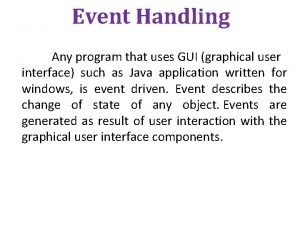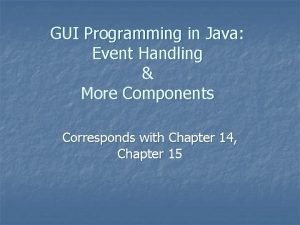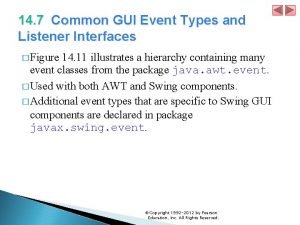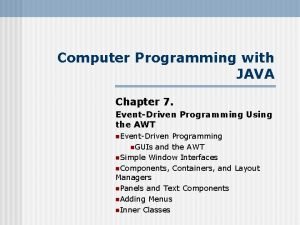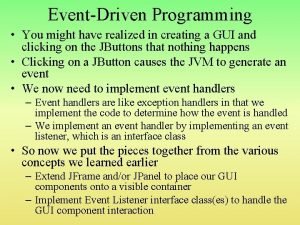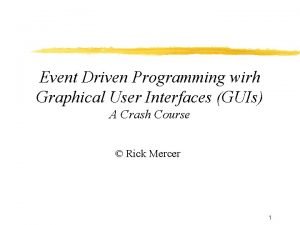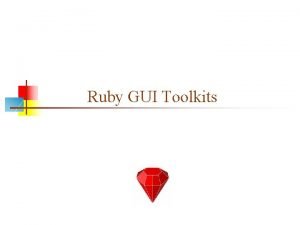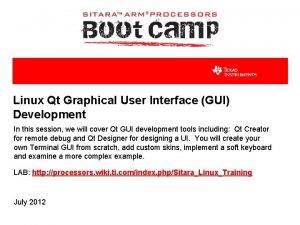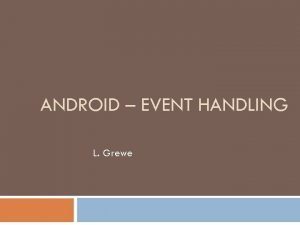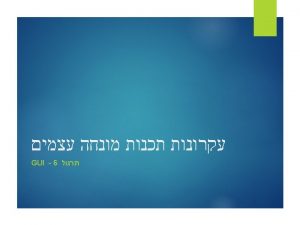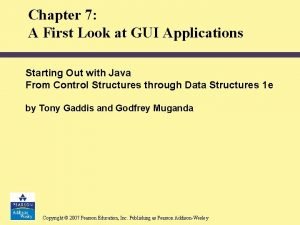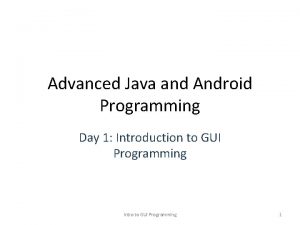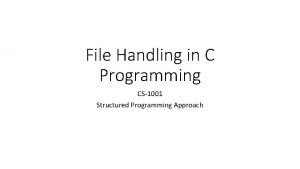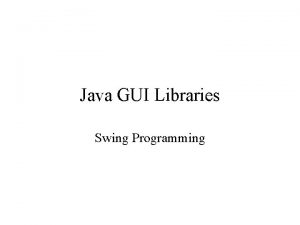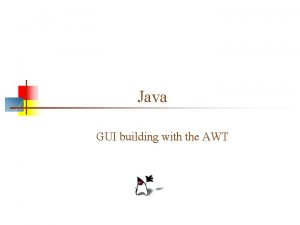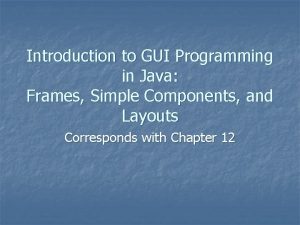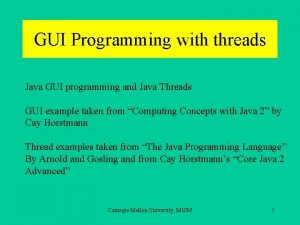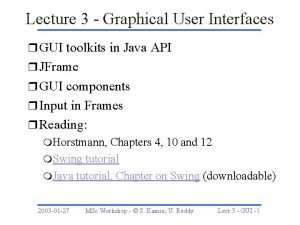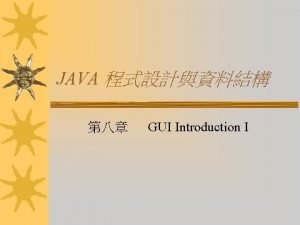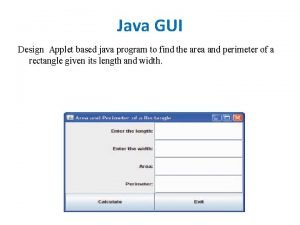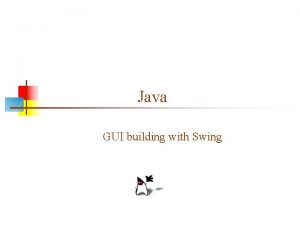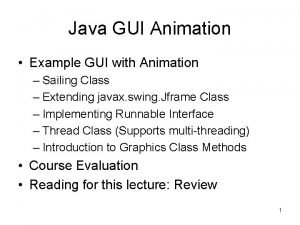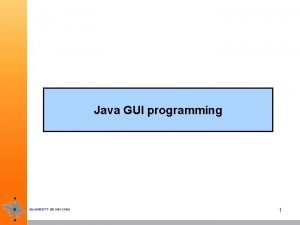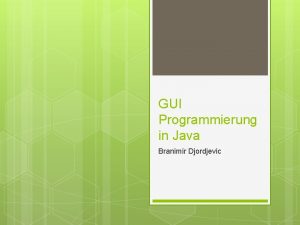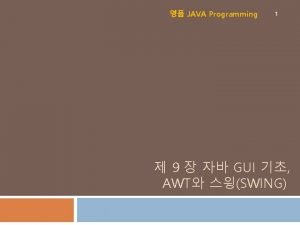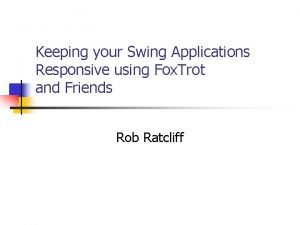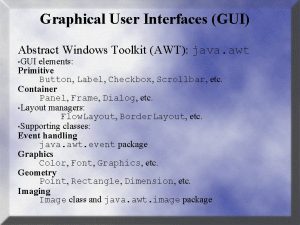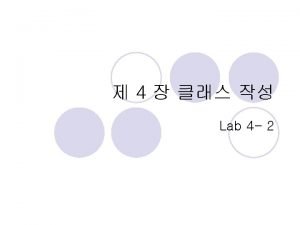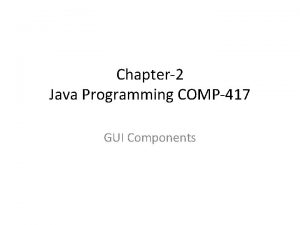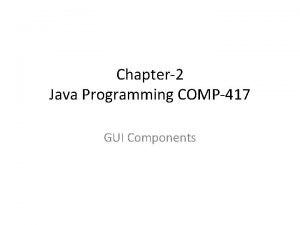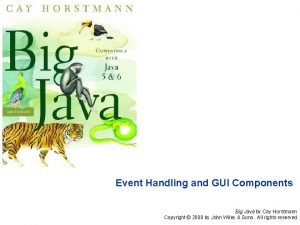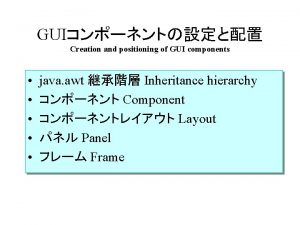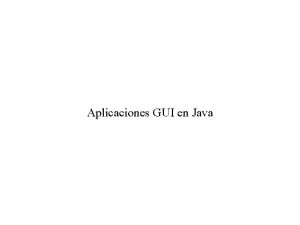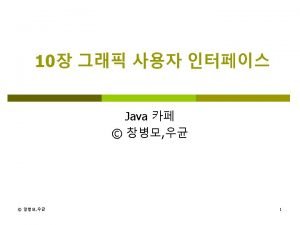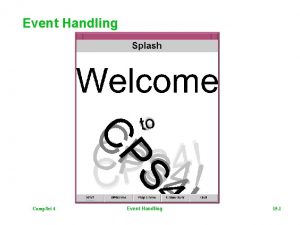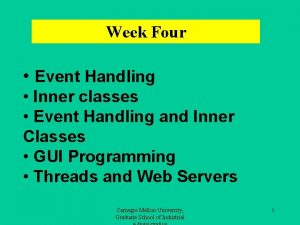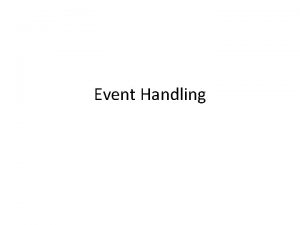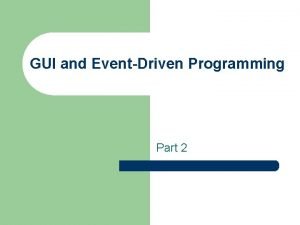GUI Programming in Java Event Handling More Components







































- Slides: 39

GUI Programming in Java: Event Handling & More Components Corresponds with Chapter 14, Chapter 15

Event-Driven Programming n Procedural programming is executed in procedural order. n In event-driven programming, code is executed upon activation of events.

Events and Listeners n n n An event can be defined as a type of signal to the program that something has happened. The event is generated by external user actions such as mouse movements, mouse button clicks, and keystrokes, or by the operating system, such as a timer. Events are responded to by event listeners

The Delegation Model Event-generating Objects send Events to Listener Objects Each event-generating object (usually a component) maintains a set of listeners for each event that it generates. To be on the list, a listener object must register itself with the event-generating object. Listeners have event-handling methods that respond to the event.

Event Classes We will focus on Action. Event and List. Selection. Event

Selected User Actions User Action Source Object Event Type Generated Click a button Click a check box Click a radio button JButton JCheck. Box JRadio. Button Action. Event Item. Event, Action. Event Press return on a text field JText. Field Action. Event Select a new item JCombo. Box Item. Event, Action. Event Select an item from a List JList. Selection. Event Window opened, closed, etc. Mouse pressed, released, etc. Key released, pressed, etc. Window Any Component Window. Event Mouse. Event Key. Event

Java AWT Event Listener Interfaces § § § Action. Listener Adjustment. Listener Component. Listener Container. Listener Focus. Listener Item. Listener § Key. Listener § Mouse. Motion. Listener § Text. Listener § Window. Listener § List. Selection. Listener All are in the java. awt. event or javax. swing. event package All are derived from Event. Listener in the java. util package NOTE: any object that will respond to an event must implement a listener interface.

How to Implement a Listener Interface n n n Use the implements keyword in the class declaration Register the object as a listener for a component’s event, using the component’s add. XListener method. (where X is the type of event). (Typically done in constructor) Declare and fully define all methods for the interface that you are implementing n Requires: n n Complete method signature Method body

Selected Event Handlers Event Class Listener Interface Listener Methods (Handlers) Action. Event Action. Listener action. Performed(Action. Event) Item. Event Item. Listener item. State. Changed(Item. Event) List. Selection Event Listener value. Changed (List. Selection. Event)

Handling Simple Action Events Implementing the listener interface Registering the frame to be a listener for action events generated by the two buttons The method for responding to an Action event.

Handling Simple Action Events – a closer look at the event-handling method action. Performed is a method required for all Action. Listeners An Event object’s get. Source() method returns a reference to the Component object that generated the event.

Alternative Approaches to Listening n Implement the listener with the main application class, and have the one listener assigned to all components generating the events n n This is the approach I generally use with my examples Advantage: simplicity for beginner programmers Disadvantage: event-handler method may require if-statement or switch with several branches when multiple components generate the event Use inner classes to implement the listeners and create a different instance as each component’s listener. n n n Named inner class or anonymous inner class (This is the approach used in the textbook most of the time) Advantage: no need to test within the listeners for determining which component sent the event. Each component has its own dedicated listener Disadvantage: harder to understand for novice programmers

Example with named inner classes, one for listening to each button Inner class has direct access to all members (even private) of the outer class

Example with anonymous inner classes, one for listening to each button

Working with JLabel, JText. Field, JText. Area, JList, JCombo. Box, and JRadiobutton Similar topics are covered in Chapter 15, but these examples are my own

JLabel n n Swing class for a non-editable text display Typical constructor: n n JLabel(string. Value) Other Useful Methods: get. Text() – returns a string containing the text in the label component n set. Text(String) – sets the label component to contain the string value n

JText. Field n n Swing class for an editable text display Many constructors possible – here’s one: n n n JText. Field(column. Width) Will instantiate a text field component of the specified width (width is approximate number of characters visible). Some useful methods: n get. Text() – returns the text value in the text field n get. Selected. Text() – returns the text value that has been highlighted in the text field n set. Text(string. Value) – sets the text value to the indicated argument n append(stringvalue) – appends the text value of the string to the already existing text in the component

JText. Area n n Swing class for an editable text display Many constructors possible – here’s one: n n n JText. Area(row. Height , column. Width) Will instantiate a text area component of the specified width and height (width is approximate number of characters visible, height is approximate number of text lines visible) Some useful methods: n get. Text() – returns the text value in the text field n get. Selected. Text() – returns the text value that has been highlighted in the text field n set. Text(string. Value) – sets the text value to the indicated argument n append(stringvalue) – appends the text value of the string to the already existing text in the component



Note use of get. Text, set. Text, get. Selected. Text and append methods.


JList n n Swing GUI component that presents a list of items Many constructors…here’s one: n n Produces a List. Selection. Event n n n JList(source. Array); Handling this event by implementing a List. Selection. Listener Need to import javax. swing. event package for this Some useful methods: n n add. List. Selection. Listener – specify which objects will respond to list selection event set. List. Data – indicate the source of data for this list (e. g. an array) get. Selected. Index – identify the current selection from the list (0 -based) -- -1 indicates nothing is selected from list. set. Fixed. Cell. Height and set. Fixed. Cell. Width – indicate pixel size of each item of the list.

JList Example 1: using lists, text fields, labels, and buttons Implementing listeners components List’s data source

JList Example 1: using lists, text fields, labels, and buttons (con’t. ) When array changes, refresh the list value. Changed is the List. Selection. Listener event handler method Use list index tp get associated array element


JList Example 2: slightly more complicated…data source is an array of objects This is the class being used for the array associated with the JList. to. String is a method that overrides the Object class’s method of the same name. This determines what will be displayed in the JList.

JList Example 2: slightly more complicated…data source is an array of objects

JList Example 2: slightly more complicated…data source is an array of objects

Exception Handling n n n This example makes use of Exception handling try/catch format NOTE: if the text entered into the numeric field cannot be parsed into a number, an Exception is thrown (specifically a Number. Format. Exeption).

try{ Exception Handling Using try and catch ……. . If code within the try block causes an error, the program will automatically branch to the catch block } catch (Exception. Type e){ ……. . }

JList Example 2: slightly more complicated…data source is an array of objects Code in the try block This may throw an exception Here we handle the exception


JCombo. Box n n Swing GUI component that presents a dropdown list of items Many constructors…here’s one: n n Produces an Action. Event and an Item. Event n n n JCombo. Box(source. Array); You can handle these event by implementing an Action. Listener or an Item. Listener If you want to handle these events, you need to import java. awt. event package Some useful methods: n n get. Selected. Index – identify the current selection from the list (0 based) -- -1 indicates nothing is selected from list. get. Selected. Item – returns the currently selected object from the list. Since it returns an Object reference, if you want to treat it as string, you should call to. String() for the returned object set. Selected. Index – Changes the current selection to whatever the integer is that is passed as an argument. set. Selected. Item – sets the currently selected item to whatever the Object is that is passed as an argument


JRadio. Button n n Swing GUI component that presents a radio buttons of options. You group the options into a Button. Group. Many constructors…here’s one: n n Since a Radio. Button is a button, it produces an Action. Event. It also generates a Change. Event n n n You can handle these event by implementing an Action. Listener or an Change. Listener If you want to handle these events, you need to import java. awt. event package Lots of useful methods…here’s three: n n JRadio. Button(Label) set. Mnemonic – Specifies a alt-Key alternative for selecting the Radio. Button. is. Selected – returns a boolean value to specify if the button has been selected set. Selected(boolean) – allows you to programmatically change the selection status of a Radio. Button Put related Radio. Buttons into a Button. Group, so only one will be selected at a time n n Instantiate the Button. Group Call the Button. Group’s add method to assign Radio. Buttons

By putting all buttons into a panel, you can place them all together in the same region of the frame’s Border. Layout By putting all buttons into a Button. Group, you ensure that only one will be selected at a time This code causes the Radio. Buttons to generate Action. Events that the frame will listen to Via set. Mnemonic, you allow Alt-1, Alt-2 and Alt-3 to select the appropriate Radio. Buttons

A component’s action command is usually its label, although you can change this The set. Selected method can be used to programmatically change the current Radio. Button selection The is. Selected method can be used to determine if a Radio. Button is selected

 More more more i want more more more more we praise you
More more more i want more more more more we praise you More more more i want more more more more we praise you
More more more i want more more more more we praise you Gui event handling
Gui event handling Java event handler example
Java event handler example Gui event types in java
Gui event types in java Event-driven programming in java
Event-driven programming in java Event driven programming in java
Event driven programming in java Ge gi gue gui güe güi
Ge gi gue gui güe güi Import java.awt.event.*
Import java.awt.event.* Event driven gui
Event driven gui Ruby graphical interface
Ruby graphical interface Linux gui development tools
Linux gui development tools Rapid gui programming with python and qt
Rapid gui programming with python and qt Event handler in android
Event handler in android Event handling in ada
Event handling in ada Swing layouts
Swing layouts Gui components
Gui components Gui components
Gui components File pointer
File pointer Gui programmierung java
Gui programmierung java Java gui awt
Java gui awt Java gui basics
Java gui basics Gui programmierung java
Gui programmierung java Picture of java
Picture of java Java gui thread
Java gui thread Programming graphical user interfaces in r
Programming graphical user interfaces in r I gui
I gui Java gui design
Java gui design Modern java gui
Modern java gui Java graphics animation
Java graphics animation First gui os
First gui os Java gui fx
Java gui fx Java gui basics
Java gui basics Gui programmierung java
Gui programmierung java 자바 gui 프로그램
자바 gui 프로그램 Kalkulator
Kalkulator How to make a gui in java
How to make a gui in java Java swing responsive gui
Java swing responsive gui Abstract windows toolkit
Abstract windows toolkit L
L


